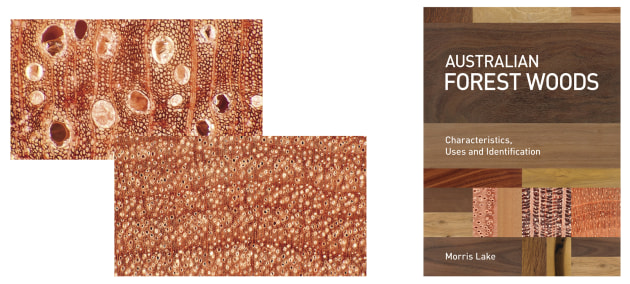Book review: Australian Forest Woods
Book review by Robert Howard
Photos supplied by Morris Lake
Australian Forest Woods (CSIRO Publishing, 2019), is the second book in this series by Morris Lake, following on from Australian Rainforest Woods (CSIRO Publishing, 2015), which was the cover story in AWR#88.
The first thing to note about these books is that both titles contain the word ‘woods’, rather than ‘trees’. The subtitle of both books is the same: ‘Characteristics, Uses and Identification’, again referring to the different woods, as well as the trees. In other words, both books are more than botany books, which usually have little or nothing to say about the wood produced by the various trees.
The correct identification of the various woods we deal with is likely to become increasingly important to us as woodworkers, as the cutting of the world’s forests becomes more political. In the mid-1980s, when importing Toona calantas as a replacement for our own Toona ciliata became a political issue in exporting countries, and had restrictions placed on it, I remember seeing slings of imported cedar arrive with ‘mahogany’ stencilled on their sides. As Morris has written, ‘knowledge and understanding go hand in hand in enhancing sustainability’.
Above: Images of the tree along with its bark, flowers and/or seedpods and wood are shown for each of the 130 species presented in the book. Shown here are those for dogwood (Pomaderris apetala).
This is particularly important to us, as Australian woodworkers, because our country has some of the oldest, and hence incredibly precious, families of woods on the planet (the Podocarpus and Araucaria species).
Both books begin with an overview of the evolution of trees in general, their botanical classification, and the current situation of our forests here in Australia. However, even though the points covered were roughly the same in both books, I was impressed to see that Morris resisted any temptation to cut and paste, and completely rewrote the material for this second book.
Both introductions repay careful reading. Here in Australia we are blessed with an estimated 5400 different wood-producing trees, but fewer than 250 of these have been commercialised. It really is quite extraordinary that there is such a large, unknown number of woods out there. It is probable that the best furniture timbers have been found and utilised, but when something like spoon carving suddenly becomes popular, we have no idea what riches remain undiscovered.
These same riches, of course, can be used for small furniture elements and details, as well as for musical instruments, woodturning, knife making, and many other woodworking pursuits requiring small (and usually highly figured) pieces of wood.
This second book describes 130 species of wood, bringing the total for the two books to 271 species. Of those in this second book, 45 are Eucalypts (with a further nine Corymbias, and two Angopheras), while 22 are Acacias. In contrast, the first book, on rainforest woods, only has one Eucalypt, and two Acacias. Given their widespread dominance of the drier parts of the Australian landscape, this is only to be expected.
I find the 22 species of Acacia, in particular, to be very exciting. Terry Gordon (of HNT Gordon Planes) is showing the world the value of gidgee, for example, while small scale, individual timber suppliers like Pete McCurly are showing the extraordinary beauty, and potential for making musical instruments, of many of our dry climate woods, including many of the Acacias covered in this book. There is a wealth of potential waiting to be realised in these under-utilised woods.
This is a very useful book, beautifully produced, full of easy to read information, and peppered with lovely anecdotes (the author’s candidate for the heaviest wood in the world; the stump that came back to life after standing ‘dead’ for over 40 years; how the tree ‘dead finish’ got its name – to name a few off the top of my head) which reflect Morris Lake’s lifelong enthusiasm for and professional interest in his subject.
This book should join its companion on the small but ever-growing shelf of must-have books for all wood lovers and woodworkers everywhere.
Robert Howard is a woodworker and sculptor who lives in Brisbane. He teaches regular woodwork classes from his studio.
Available from www.publish.csiro.au
1. The book also presents macrophotographs of selected species by Jean-Claude Cerre. These show the structure of native cherry (Exocarpos cupressiformis).
2. Morris Lake stands at the base of The Big Tree, a 400 year old stringbark (Eucalyptus obliqua) with a girth at its base of 16 metres.
3. The book is hardcover with 218 pages and over 900 images.




